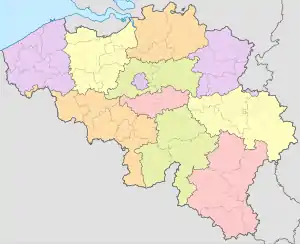Fusion of the Belgian municipalities
The fusion of the Belgian municipalities (French: fusion des communes, Dutch: fusie van Belgische gemeenten) was a Belgian political process that rationalized and reduced the number of municipalities in Belgium between 1975 and 1983. In 1961, there were 2,663 such municipalities; by 1983, these had been re-arranged and combined into 589 municipalities.

The project of merging a number of local authorities to improve service delivery by streamlining administration and creating economies of scale was the work of the government headed by Leo Tindemans (1974–1978), and in particular of Interior Minister Joseph Michel. The legal framework in which the mergers would be implemented was laid out in an act passed by the Belgian Parliament on 30 December 1975.[1]
After several decades without any change, fifteen Flemish municipalities would be merged into seven on 1 January 2019, reducing the number of Flemish municipalities from 308 to 300, and the Belgian total from 589 to 581.
References
- M. Lazzari, P. Verjans and A.-L. Durviaux, La fusion des communes: une réforme trentenaire (Merger of municipalities: a thirty-year old reform), Territoire(s) wallon(s), special issue (August 2008), pp. 27-34.
See also
- List of municipalities of the Brussels-Capital Region (19 municipalities)
- List of municipalities of the Flemish Region (300 municipalities)
- List of municipalities of the Walloon Region (262 municipalities)
